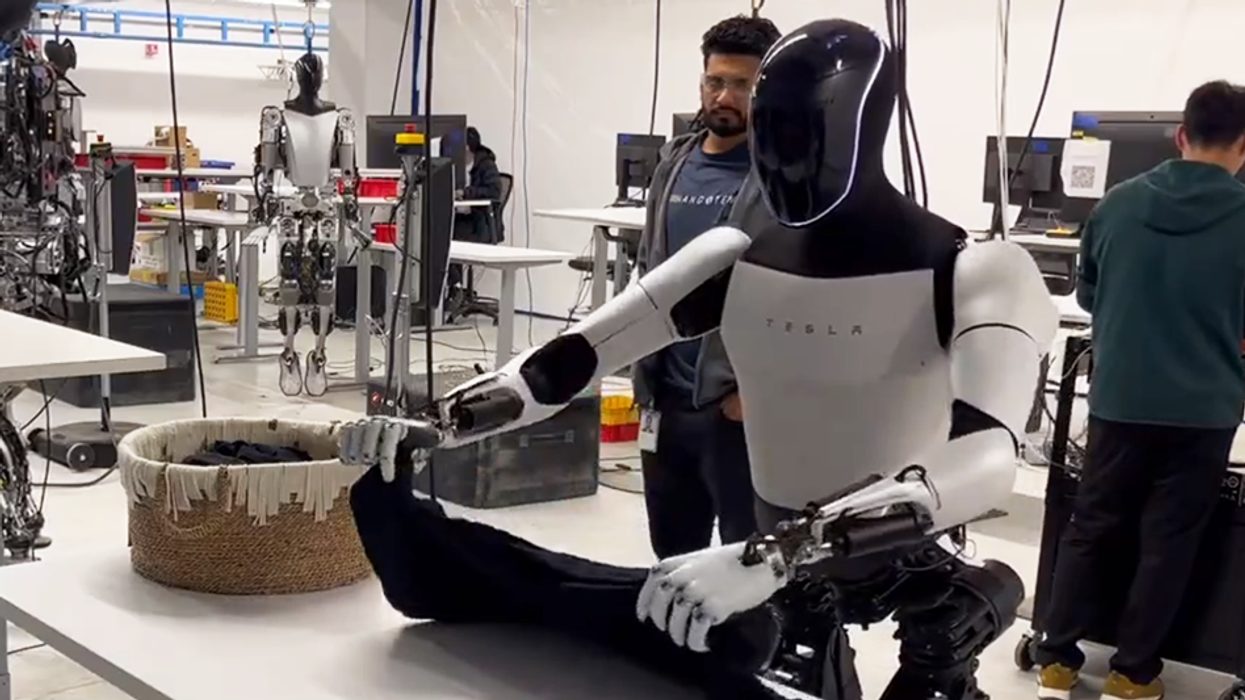
Image via Elon Musk / X (screenshot)

Elon Musk showcased a video of a Tesla robot folding a shirt just a few short months after both the menial task and robot technology was revealed.
The robots, called "Tesla Optimus," are described as "general purpose, bi-pedal," and "humanoid" robots that are capable of performing tasks that are "unsafe, repetitive or boring."
The bots made their first big reveal in May 2023 and were shown walking around and "learning about the real world."
At the same time, a group of scientists and robotics engineers developed a robot that can learn an individual's cleaning habits and techniques to properly organize their living space and throw out waste.
The "Tidybot" included input from Princeton, Stanford, and Columbia University engineers, along with help from Google and the Nueva School.
One of the engineers posted about the technology as early as May 2023 as well.
While it is unclear whether either technology derived from the other, it was only two months later that the Tesla Optimus revealed it was capable of sorting objects on its own.
"Optimus can now sort objects autonomously," the company wrote on X. "Its neural network is trained fully end-to-end: video in, controls out."
By the second week of 2024, Musk unveiled a video of the same robot carefully removing a T-shirt from a laundry basket before gently folding it on a table.
"Optimus folds a shirt," Musk wrote.
The robot is seen carefully arranging the shirt on the table before starting its task while almost seeming to possess too much strength for the intricate feat.
When the Tidybot was released, engineers revealed how their robot was able to properly organize household items.
The robot worked by having users input (in text) a small number of sample preferences that instructed the robot as to where items should be placed. For example, "yellow shirts go in the drawer, dark purple shirts go in the closet," the product's abstract described.
This allowed the robot to summarize "large language models" and generalize information to apply to other items it may come across. Therefore, it could generally summarize that "light-colored clothes go in the drawer and dark-colored clothes go in the closet."
The robot could identify objects and receptacles through a database of images it had, meaning it recognized what a shirt or a recycling bin looked like. "The robot will then carry out the cleanup task by repeatedly picking up objects, identifying them, and moving them to their target receptacles," the document stated.
The engineering team said that their approach achieved a 91.2% accuracy rating on unseen objects in their scenarios. In real-world applications, the robot reportedly correctly put away 85% of objects.
When organizing a home, everyone has unique preferences for where things go. How can household robots learn your preferences from just a few examples?\n\nIntroducing \xf0\x9d\x97\xa7\xf0\x9d\x97\xb6\xf0\x9d\x97\xb1\xf0\x9d\x98\x86\xf0\x9d\x97\x95\xf0\x9d\x97\xbc\xf0\x9d\x98\x81: Personalized Robot Assistance with Large Language Models\n\nProject page: https://t.co/LbVGq01QMT— (@)
Like Blaze News? Bypass the censors, sign up for our newsletters, and get stories like this direct to your inbox. Sign up here!
Andrew Chapados